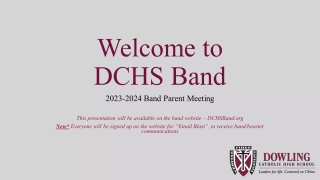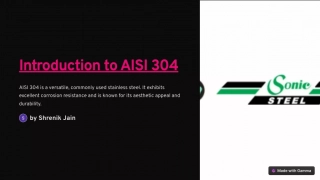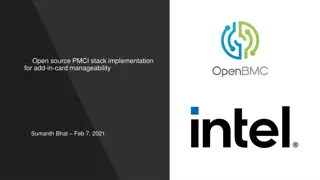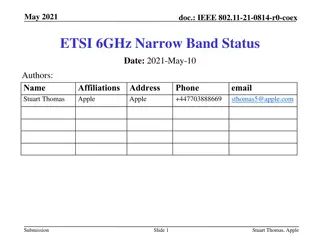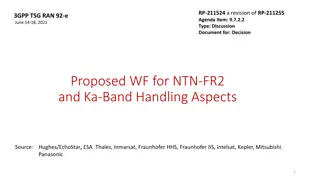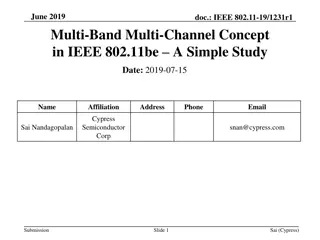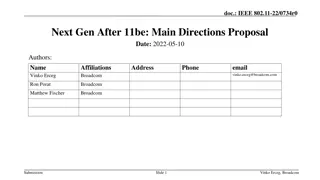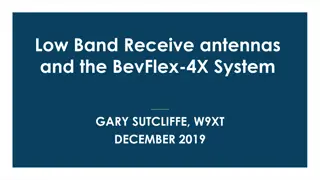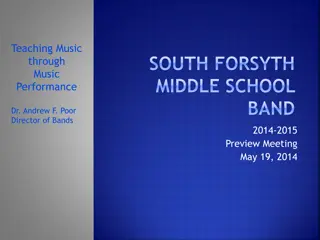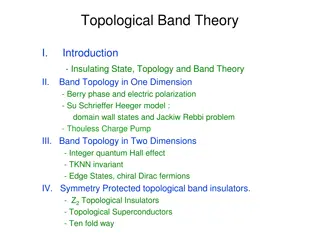C2.Link 5GHz Band Planning Overview
The C2.Link 5GHz Band Planning involves allocation to AM(R)S, AMS(R)S, and ARNS on a co-primary basis, with ICAO systems and MLS given priority. RTCA MOPS for a terrestrial C2 Link system and EUROCAE MOPS for a geostationary satellite-based system were released. The use of TDD waveforms in RTCA DO-362 allows for efficient operation without complex filtering. EUROCAE ED-265 details the service link between RPAs and satellites. Challenges with interference and noise between terrestrial and satellite systems have been identified. Various studies have been conducted to assess separation and coordination strategies.
Download Presentation

Please find below an Image/Link to download the presentation.
The content on the website is provided AS IS for your information and personal use only. It may not be sold, licensed, or shared on other websites without obtaining consent from the author.If you encounter any issues during the download, it is possible that the publisher has removed the file from their server.
You are allowed to download the files provided on this website for personal or commercial use, subject to the condition that they are used lawfully. All files are the property of their respective owners.
The content on the website is provided AS IS for your information and personal use only. It may not be sold, licensed, or shared on other websites without obtaining consent from the author.
E N D
Presentation Transcript
C2 Link C2 Link 5 GHz Band Planning 5 GHz Band Planning - - Status Update Status Update - - RPAS Panel WG2 FSMP WG/12-IP/01 - Agenda 6 b) 4-15thOctober 2021
C2 Link 5GHz Band Planning - Background The 5030-5091MHz part of C Band is allocated to AM(R)S, AMS(R)S and ARNSon a co-primary basis Footnote 5.444, ICAO systems, MLS given priority in the 5030-5091MHz part of its allocation Footnote 5.443C, AM(R)S, ICAO systems, must protect RNSS in 5010-5030MHz Footnote 5.443D, AMS(R)S, ICAO systems, must be coordinated under 9.11A In September 2016 RTCA released a MOPS for a terrestrial C2 Link system operating in the 5030-5091MHz band In December 2020, the MOPS was updated (DO-362A) to include an airborne relay component In May 2018 EUROCAE invited comments on a draft MOPS for a geostationary satellite based C2 Link system operating in the 5030-5091MHz band 2
C2 Link 5GHz Band Planning RTCA DO-362 To avoid the need for expensive and bulky filtering, which would be required for FDD, DO-362 is based on a TDD waveform Air-to-Air and Ground-to-Ground interference cannot occur with TDD Filter rejection requirements for FDD would lead to significantly less useable bandwidth than the 61MHz of bandwidth that is available Filter size and weight constraints for FDD would counter low RF loss so impacting receiver performance and transmitter DC power efficiency A 50ms TDD frame was chosen to minimize the latency (e.g., for voice) and still not cause challenges with the fading dynamics of the terrestrial multipath propagation C2 Link recovers quickly after a fade Fading at the TDD rate does not typically occur during flight so no complex fast-fading tracker is required in the receiver 3
C2 Link 5GHz Band Planning EUROCAE ED-265 The service link between the RPA and satellite uses a 300msec TDD frame containing 5 (60msec) TDMA time slots The UA transmits and receives at different times so no diplexer is required From FSMP-WG/03-WP/10 The satellite to UA and UA to satellite links operate on different frequencies and the satellite uses a diplexer to separate the RTN and FWD transmissions for all of the RPA it supports in each spot- beam From FSMP-WG/03-WP/10 4
C2 Link 5GHz Band Planning Sharing So, given the different TDD time frames, the potential for Air- to-Air and Ground-to-Ground interference between the terrestrial and satellite equipped UA and ground systems exists Since no RF filtering is feasible, wideband noise from each system s transmitters can be received by the other systems receivers A number of studies have been performed (in the FSMP, RPASP, EUROCAE and RTCA) to assess the frequency and spatial separations required to manage the interference to acceptable levels Different studies did not always use the correct or most up to date parameter values ED-265 receiver rejection increase will be required RPASP/ENAC recently completed its final study 5
C2 Link 5GHz Band Planning Sharing Air-to-Air separations of 250m to 520m required between terrestrial and satellite equipped UA, assuming a frequency offset of > 2MHz 6
C2 Link 5GHz Band Planning Sharing Separations of 3km to 5km between satellite equipped UA and terrestrial ground stations required, if the satellite equipped UA operates below 240m to 350m, assuming a frequency offset of >2MHz 7
C2 Link 5GHz Band Planning Sharing To mitigate the Air-to-Ground interference between satellite equipped UA and terrestrial ground stations the RPA could only use satellite when operating above 240-350m altitude May be necessary to use the lower latency terrestrial link for takeoff and landing However, this will require careful system design to ensure C2 Link continuity for both terrestrial and satellite systems to be installed on the same aircraft Does not resolve the more challenging Air-to-Air interference which TDD with a common frame timing would eliminate 8
C2 Link 5GHz Band Planning Sharing Are these separations adequate? Aircraft are normally separated by at least 1,000 ft (300m) vertically and 3-5NM (5-8km) horizontally However, if those separations are lost RPAS rely on ATC instructions, Detect and Avoid Systems alerts and TCAS Resolution Advisories to mitigate the risk of collision ATC communicate with remote pilot using the UA s VHF radio relayed through the C2 Link DAA target tracks sent over the C2 Link to the remote pilot In response to either input the remote pilot sends maneuver commands over the C2 Link to the UA All of these mitigations could be blocked if interference occurred RTCA is performing analysis to see how less effective the DAA system would be if the C2 Link was unavailable inside the separations determined in the sharing analysis 9
C2 Link 5GHz Band Planning Sharing What can be done to reduce the separation requirements? Change the TDD time frames Increasing the terrestrial TDD frame time increases voice latency, which is already marginally complaint even on the terrestrial C2 Link Reducing the satellite TDD frame time, because of delay spread, reduces the maximum longitudinal offset between the satellite and the UA so more satellites are required RTCA DO-362A contains an example satellite link design that uses 50ms TDD, so is compatible with the terrestrial system, but it is limited to just cover the USA s +/- 25 degrees longitudinal offset not the +/- 60 degrees that is desired by EUROCAE Use C/I+N rather than I/N in the analysis The terrestrial link operates at a high fade margin so at less than maximum range it has a robust C/N to combat interference The satellite link operates at a low fade margin and does not have an intra- system need for significant interference protection so has a limited C/N to absorb any interference 10
C2 Link 5GHz Band Planning Sharing What can be done to reduce the separation requirements? Segment the allocation and impose RF filtering in the terrestrial and satellite RPA transmitters To provide a 10 times reduction in separation would require approximately 20dB of filter rejection with an approximately 4dB reduction in link margin 1.5kg and $5,000 10MHz passband, 25MHz stopband at -20dB Approximately 30MHz of useable spectrum would be available in the 61MHz allocation 11
C2 Link 5GHz Band Planning Sharing RPASP WG2 sees the 5030-5091MHz, AM(R)S/AMS(R)S allocation as a valuable C2 Link asset and wants to enable equitable access to both terrestrial and satellite solutions RPASP WG2 would value any feedback and suggestions from the FSMP on how to achieve that goal 12


